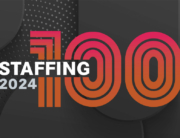At the 2019 Staffing Industry Analysts Executive Forum, SIA President Barry Asin and Charted Path founder Mike Cleland led a session on their book, Breaking Through: Leadership Disciplines from Top-Performing Staffing Firms. This issue of Staffing Industry Review contains excerpts from the session. The authors share what they learned when talking with leaders of staffing firms that have successfully broken the barriers of growth to exceed the $100 million mark. This top-most category represents only 1% of US staffing firms, or 140 firms. The remaining issues of the year will highlight the three case studies presented in the session. Here, Asin and Cleland identify traits that differentiate these firms and their leaders.
Barry Asin: Three years ago, Mike and I were talking about the way that the staffing industry looks: There are roughly 19,000 firms, 80% of which generate less than $5 million in revenue, 90% of them are under $10 million. What is it about the ones that get beyond that? Particularly, what is it about those that get to $100 million? What’s different about them?
Mike Cleland: Through my consulting business, I saw patterns in terms of stages when companies stopped growing, which is what really led to our conversation.
Growth Stages
In order to grow, the top executive has to be willing to delegate and take on risk, and the leadership team needs to mature and develop capabilities. We have identified four stages of business growth: Owner/operator-dependent, independent operation, organic scale, and strategic expansion (See Figure 1).
Owner/operator. The owner/operator stage is the beginning, and how most staffing firms start. The owner-operator is directly involved in driving day-to-day production. If they leave, if they go on vacation, production takes a hit.
These firms can actually have decent growth if they have a solid client base — they can even reach $10 or $15 million. But that growth can’t be diversified because of the bandwidth of the executive driving most of the sales.
Independent operation. The first stage of real growth leads to independent operation. At this point, the organization hires the first line-level management, and the executive may be involved in sales from a strategic standpoint, but not from a day-to-day standpoint.
Organic scale. To grow further, the leader typically thinks about geographic expansion, because they can only grow so much out of a single operation. That’s where you achieve organic scale — replicating that operation.
It’s one thing to be able to do it when you are in the office and you are walking around; you are still able to make corrections on a day-to-day basis. But now you have to start growing, and in a branch model, for example, you’re not at each location to see it. So now you’re taking a lot more risk, you have a lot more investments going on in order to accomplish organic expansion — you’re invested in offices and more capital is tied up in the business.
So, in terms of delegation and risk, this is a major step. This is often when the owner starts hedging a little bit and saying, “You know what, I’m not really ready to make that leap.”
Strategic expansion. Finally, you have to bring in different offerings in order to grow. And because you are taking leadership time and attention and resources away from the core business, the core business has to be strong. Once that core is strong, you can make adjacent investments and be able to expand your market share in that way.
Asin: This was the theory we had about how it worked in the real world. And not all organizations move exactly like this.
Disciplines
Asin: Our talks with companies that have had a break-through success story helped us identify traits that differentiate these firms and their leaders. We call these the disciplines that break-through organizations have. (See Figure 2).
Commitment
Asin: Those disciplines start with commitment. What is it that you’re trying to achieve with the business? Typically, that can be really personal. It’s about the owner or the partners who have started the business. What do they really want out of it? Is it an exit in a few years, is it to build a family legacy, is it just a job or is it a lifestyle business?
Cleland: There’s obviously all types of reasons why you all started a business. But the question is, how do you use that purpose and reason? How do you translate that in a way that makes it compelling for your team, something that they can identify with?
The fact is, we need to really reflect and understand why we are doing this. That’s what you fall back on in hard times. When things go south, that’s where you are going to pull energy from — it’s from the purpose. It’s the willingness to make short-term sacrifices for the long-term growth of something exceptional. And you have to be able to translate that to where you spend your time, and that’s something that we saw across the board with everybody we studied.
The person who’s willing to grow that business is willing to take financial risks, putting faith in their team that they will be able to do something with this. They make professional sacrifices, they let go of employees who maybe grew the company with them, who were friends at one point.
Asin: If you looked at all the staffing firms that haven’t grown, often there is a conflict between their actual purpose and what they are saying they want to do. Probably the biggest one is telling people that they want to grow and that there is a bigger future here, when the actual purpose, and the way they behave, indicates that the business is more of a lifestyle business. There is absolutely nothing wrong with a lifestyle business, but it’s pretty rare to somehow grow to $100 million on your lifestyle business.
Direction
Asin: Direction is about strategy. There’s no coincidence that the majority of the companies on SIA’s Fastest-Growing US Staffing Firms list are in healthcare and IT. Those are strategic decisions that, over the past five or 10 years, made it easier to grow. One of the folks we interviewed, [Hire Dynamics’ founder] Dan Campbell, quoted one of his mentors, Guy Milner, who founded Norell: “Never underestimate the value of a good tail wind.” Making the strategic choice, being in the right market — that helps a lot.
Cleland: The core points of direction include: A well-defined market strategy, operations that really support that strategy and the ability to adapt to new threats and opportunities. To boil it down, direction is about being a visionary. … So, it’s a clear vision, it’s a disciplined vision, one that people can understand, buy into and execute. That’s direction.
Culture
Asin: When we started this, culture was the thing that we first latched on to. It struck me that there is a huge correlation between the firms on our Fastest-Growing US Staffing Firms list and the firms on our Best Staffing Firms to Work For list. And I think that’s not a coincidence. The folks on Best Staffing Firms to Work For are focused on their culture.
Every organization has a culture. The question is, do you have a culture by design or do you have a culture by default? A high-performance culture is well-aligned with the companies that have had really fast growth.
Cleland: Culture is really about setting the rules of behavior, that people know how to interact with one another, how to hold each other accountable. If you look at leadership’s role, obviously it’s as a standard-bearer of the culture. Yes, you come up with the values and have to live the values, and so do your leaders.
Talent Development
Asin: This is the idea to focus on hiring and coaching and promoting internal talent, the people who are actually going to grow the team. This discipline is one of the big differentiators between good staffing firms that are single-branch and those that have the ability to grow more talent, the ability to replicate something that works really well at one place and do it somewhere else. That is all about talent development.
Cleland: Talent development is almost like a sports team, which has a general manager, who is responsible for hiring and putting the people together. And then there’s the coach, who’s responsible for training and coaching them up and motivating them. As a staffing leader, you’re basically playing both roles.
One of the mistakes that people made is that motivation is actually the most crucial factor in the development of the team. You can have an online training platform, you can do whatever you want, but if your team is not motivated to change, they’re not going to improve. Looking at yourself as a coach in terms of driving that behavior is central to talent development.
Asin: [During a presentation at the 2019 Executive Forum, Bowstring Advisors Founder] Jim Childs talked about Apex and Insight Global. There is no coincidence that a number of the fast-growing companies that we see out there, that have really had break-through growth stories, are spun out of Allegis. And Insight and Apex were both founded by Allegis alumni. If you talk to senior leaders at Allegis, they will tell you that they don’t see themselves so much in staffing as they do in the business of growing leaders.
Cleland: You always want to be ahead of your hiring needs. That’s the one way you can really control who works for you. Not being in proactive control of who’s working for you is one of the biggest mistakes that you can make. You should always be recruiting. That’s one of the things that [ALKU founder and CEO] Mark Eldridge talks about. Budgets are great, but they shouldn’t determine when you hire somebody. You should hire somebody when you find the right person. So that means you always have to be proactively recruiting and that way you don’t have to compromise and hold on to people that might not be performing, but instead you’re constantly making the team better.
Execution
Asin: Execution is the final discipline, and the one most people go to first, when they ask how they can accelerate their growth, how they can recruit, how they should comp their salespeople. What levers do they pull?
All of those things are hugely important, but you’ve got to have these other disciplines in place to really make that work.
Cleland: Execution is typically what people are really focusing on. It’s like, do I need to bring in a new tool or how do I do this better? That type of thing. Which is great and it’s incredibly important. The problem is that, for example, if you have a bad culture, it doesn’t matter what tool you bring in. You don’t have the right people, it doesn’t matter what processes you have. If you have no culture, your policies don’t matter.








